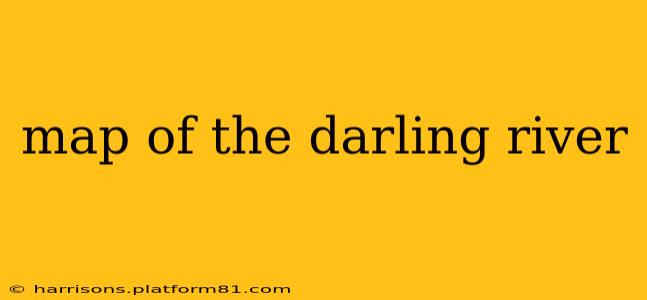The Darling River, Australia's longest river, is a majestic waterway winding its way through the heart of the country. Understanding its geography is key to appreciating its ecological significance and the challenges it faces. This guide provides a comprehensive overview, incorporating answers to frequently asked questions, and offers a deeper understanding of this iconic Australian landmark.
While a single, universally accepted "map of the Darling River" doesn't exist (as detailed maps often focus on specific sections due to its length and branching tributaries), numerous resources provide detailed cartographic information. These range from online mapping tools (like Google Maps, which allows for detailed exploration) to specialized topographic maps available through government agencies and surveying companies. For highly specific needs, consulting professional geographical resources is recommended.
What is the source of the Darling River?
The Darling River's source is debated, but is generally considered to be near the confluence of several smaller creeks and streams in the Great Dividing Range of New South Wales, around the area of the Macintyre River. This region experiences significant rainfall, feeding the headwaters and setting the river on its long journey westward. The exact point is difficult to pinpoint due to the highly variable nature of the headwaters and the diffuse nature of the source streams.
How long is the Darling River?
The Darling River itself stretches approximately 1,472 miles (2,370 kilometers). However, including its tributaries and the overall length of the Murray-Darling Basin system (of which it is a major component), the total length significantly increases. The combined length of the Murray-Darling Basin system makes it one of the largest river systems in the world. The length is sometimes a subject of debate due to the meandering nature of the river and its numerous tributaries.
Where does the Darling River flow into?
The Darling River meets the Murray River at Wentworth, New South Wales. This confluence forms the largest river system in Australia. The combined flow then continues westward towards the Southern Ocean. The point of confluence is a significant geographical landmark and a popular tourist destination.
What are the main tributaries of the Darling River?
The Darling River has numerous tributaries, significantly increasing its catchment area and overall water volume. Some of the most important include the Culgoa River, the Namoi River, the Macquarie River, and the Bogan River. These tributaries contribute substantial volumes of water and play a crucial role in the river system's hydrology. Understanding their individual characteristics helps to analyze the overall health and flow of the Darling.
What is the importance of the Darling River?
The Darling River holds immense ecological, economic, and cultural significance. Ecologically, it supports a rich and diverse array of flora and fauna, including many threatened species. Economically, it plays a vital role in agriculture, particularly irrigation, and supports industries reliant on the river system's resources. Culturally, the Darling River holds deep meaning for Aboriginal communities who have lived alongside it for thousands of years. Their connection to the river is integral to their cultural heritage and traditions.
What are the current environmental challenges facing the Darling River?
The Darling River faces numerous environmental challenges, many linked to climate change, agricultural practices, and water management. These include prolonged droughts, salinity issues, and the impact of invasive species. Water extraction for irrigation has also significantly impacted river flows, affecting the health of the ecosystem. Ongoing research and management strategies are crucial to ensuring the long-term sustainability of the river system. Understanding these challenges is key to supporting effective conservation efforts.
Where can I find detailed maps of the Darling River?
As mentioned previously, there is no single definitive map. High-quality maps can be found from various sources including:
- Online mapping services: Google Maps, Bing Maps, and other online mapping tools provide detailed views and allow for navigation along the river's course. While not always highly specific for hydrological detail, these tools provide a good general overview.
- Government agencies: State and federal government agencies responsible for water management and environmental monitoring often publish maps and hydrological data. Searching for these agencies' websites (relevant to NSW and potentially QLD) will yield results.
- Specialized mapping companies: Companies specializing in topographic mapping and GIS services can provide high-resolution maps for specific areas of the Darling River. These maps will usually require a purchase.
By utilizing these resources, you can piece together a comprehensive picture of the Darling River's location and its vast geographical reach. Remember that the specific details you find will depend on your requirements and the level of detail required for your purpose.
